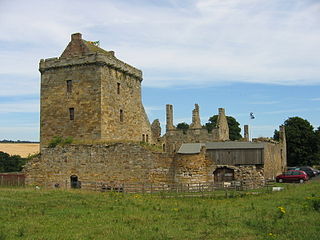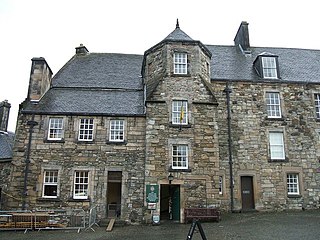Related Research Articles

James IV was King of Scotland from 11 June 1488 until his death at the Battle of Flodden in 1513. He inherited the throne at the age of fifteen on the death of his father, James III, at the Battle of Sauchieburn, following a rebellion in which the younger James was the figurehead of the rebels. James IV is generally regarded as the most successful of the Stewart monarchs. He was responsible for a major expansion of the Scottish royal navy, which included the founding of two royal dockyards and the acquisition or construction of 38 ships, including the Michael, the largest warship of its time.

The ruins of Linlithgow Palace are located in the town of Linlithgow, West Lothian, Scotland, 15 miles (24 km) west of Edinburgh. The palace was one of the principal residences of the monarchs of Scotland in the 15th and 16th centuries. Although maintained after Scotland's monarchs left for England in 1603, the palace was little used, and was burned out in 1746. It is now a visitor attraction in the care of Historic Environment Scotland.
Margaret Drummond was a daughter of John Drummond, 1st Lord Drummond, and a mistress of King James IV of Scotland.

Dumbarton Castle has the longest recorded history of any stronghold in Scotland. It sits on a volcanic plug of basalt known as Dumbarton Rock which is 240 feet (73 m) high and overlooks the Scottish town of Dumbarton.

Dunbar Castle was one of the strongest fortresses in Scotland, situated in a prominent position overlooking the harbour of the town of Dunbar, in East Lothian. Several fortifications were built successively on the site, near the English-Scottish border. The last was slighted in 1567; it is a ruin today.

Sir James Hamilton of Finnart was a Scottish nobleman and architect, the illegitimate son of James Hamilton, 1st Earl of Arran, and Marion Boyd of Bonshaw. Although legitimated in 1512 while still a minor, he continued to be known as the "Bastard of Arran". As a key member of the Hamilton family, and second cousin of James V, King of Scotland, he became a prominent member of Scottish society.

Balgonie Castle is located on the south bank of the River Leven near Milton of Balgonie, 3.5 kilometres (2.2 mi) east of Glenrothes, Fife, Scotland. The castle keep dates from the 14th century, and the remaining structures were added piecemeal until the 18th century. The keep has been recently restored, although other parts of the castle are roofless ruins. Balgonie, excepting the tower which is used for residential purposes, is a Scheduled Ancient Monument. This castle is the subject for several ghostlore stories, including a green lady story.
Janet Kennedy, was a Scottish noble and the mistress of King James IV of Scotland.

Alexander Elphinstone, 1st Lord Elphinstone was a Scottish peer. He was the son of Sir John Elphinstone of that ilk and of Pittendreich.
William MacDowall or McDougall(died 1580) was a Scottish priest and Master of Works to Mary, Queen of Scots, her mother Mary of Guise, and James VI of Scotland. The title 'sir' was used in Scotland by a priest without a master's degree. The name appears variously as McDowgall, McDougall, McDowall etc., in printed records, he signed accounts MAKDOUELL.

The Scottish royal tapestry collection was a group of tapestry hangings assembled to decorate the palaces of sixteenth-century kings and queens of Scotland. None appear to have survived.
John Drummond of Milnab was a 16th-century Scottish carpenter in charge of the woodwork of the palaces, castles and guns of James IV of Scotland and James V of Scotland.
Don Pedro de Ayala also Pedro López Ayala was a 16th-century Spanish diplomat employed by Ferdinand II of Aragon and Isabella I of Castile at the courts of James IV of Scotland and Henry VII of England. His mission to Scotland was concerned with the King's marriage and the international crisis caused by the pretender Perkin Warbeck. In his later career he supported Catherine of Aragon in England but was involved in a decade of rivalry with the resident Spanish ambassador in London. Ayala was a Papal prothonotary, Archdeacon of London, and Bishop of the Canary Islands.
John Chisholm was a 16th-century Scottish soldier and the chief officer, Comptroller and Prefect of the Scottish artillery for Mary, Queen of Scots and James VI of Scotland. He was also keeper of the King's Wark in Leith. Chisholm was a supporter of Mary, Queen of Scots in the years after her exile in England.
David Betoun of Creich (1466–1505) was a Scottish landowner and courtier.
James Hommyll, was a wealthy merchant in Edinburgh.

Andrew Aytoun, was a Scottish soldier and engineer, and captain of Stirling Castle.

Walter Merlioun, was a Scottish master mason based in Edinburgh.

John Mosman was an apothecary at the Scottish court.
John Campbell of Lundy or Lundie was a Scottish lawyer and courtier.
References
- ↑ ' Accounts of Duncan Forrester of Skipinch' in, Ninth Miscellany of the Scottish History Society, SHS (1958), 66.
- ↑ Accounts Lord High Treasurer of Scotland, vol.1 (1877), 290.
- ↑ Fraser, William, The Stirlings of Keir, (1858), p.128
- ↑ Accounts of the Lord High Treasurer of Scotland, vol.1 (1877), cxxxii-cxxxiv, 269
- ↑ McGibbon & Ross, Castellated & Domestic Architecture, vol.5 (1892), p.530: Accounts Treasurer, vol.1 (1877)
- ↑ Accounts of the Lord High Treasurer of Scotland, vol.2 (1900), p.xii
- ↑ Macdougall, Norman, James IV, Tuckwell (1997), p.155